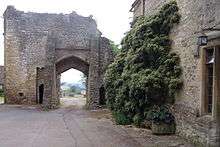Beverston Castle
| Beverston Castle | |
|---|---|
| Gloucestershire, England | |
|
Beverston Castle south tower of western range | |
 Beverston Castle | |
| Coordinates | grid reference ST861939 |
| Site information | |
| Owner | Private |
| Open to the public | No |
| Condition | Inhabited |
| Site history | |
| Materials | Limestone |
| Events | English Civil War |
Beverston Castle, also known as Beverstone Castle or Tetbury Castle, was constructed as a medieval stone fortress and is situated in the village of Beverston, Gloucestershire, England. The castle was founded in 1229 by Maurice de Gaunt.[1] Much of the castle was in the state of ruin in 2011, but a portion of the structure is occupied, and an expansive handsome garden is part of the estate. The castle is situated in the centre of Beverston village, approximately 200 metres north of the A4135 road transecting Beverston.
Description
The original castle design was in an approximately pentagonal form; later in the early 14th century, a small quadrangular stronghold was added along with a twin-towered gatehouse. Beverston Castle is situated approximately three kilometres west of the town of Tetbury and about two kilometres east of the medieval abbey annex, Calcot Manor. The castle is situated in the Cotswolds, a designated Area of Outstanding Natural Beauty (AONB), which is an area of countryside with significant landscape value in England, Wales or Northern Ireland, that has been specially designated by the Countryside Agency.
History

Early Roman remains have been found in the near vicinity at Calcot Manor, indicating habitation of this area as early as the 5th century,[2] although it is likely that earlier Iron Age peoples would have also been in this locale. In the Middle Ages it was called Beverstane, and in medieval times the site was known as Beverstone. Another early name for this site was Bureston, derived from the large number of blue stones found here.[3]
The site was the location of an important circa 1140 AD battle between the opposing English armies of King Stephen and Empress Matilda.[4] Maurice de Gaunt constructed the original castle somewhat prior to 1229 without a royal licence, but was granted a licence to crenellate. This early castle was fortified by a T-shaped ditch, part of which is still intact in the appearance of a partial moat on the south side of the castle. In the early 14th century, Thomas, Lord Berkeley, the rich (1293–1361), modified Beverston Castle, erecting a small quadrangular stronghold, with a twin-towered gatehouse. A smaller square tower was added in the late 15th century.
In the 16th century, Sir Michael Hicks (son of from London and Julia Arthur) owned Beverston Castle and passed the Beverston holding to his son Sir William Hicks, 1st Baronet. The estate remained in the Hicks family through at least the early 19th century. From military outfall of the Civil War (mid-seventeenth century), much of Beverston Castle was destroyed.[5] Roundhead forces attacked the castle twice during the Civil War, but the greatest blow may have been an order from Parliament to dismantle its defensive works. The western and southern ranges along with the gatehouse with one of its original D-shaped towers have survived.
Architecture
The massive extant west range of Beverston Castle is flanked on its angles with square towers, and it contains a solar above a vaulted undercroft. The pentagon-shaped masonry castle has two surviving, albeit ruined, round towers from the original 13th-century construction of de Gaunt. The dressed bluish limestone appears to be of the same quarry source as nearby Calcot Manor. The two-storey gatehouse, with one extant D-shaped tower, was added by Lord Berkeley in the 1350–1360 era. The gatehouse arch, totally intact as of 2006, would have originally been protected by an immense portcullis. Above the archway was a sizable first floor (second story in American vernacular) chamber. The ruined northwest square tower dates to the 14th century (Lord Berkeley's work), further modified in the late 15th century.
The southern domestic range, occupied as of 2006, was built by the Hicks family in the early 17th century, reflecting an age of growing security for large manor houses. This range was originally occupied by a medieval great hall from either the de Gaunt or Berkeley era. In the year 1691 a fire damaged this southern range, which was restored soon thereafter.
Present aspect
In 2006, Beverston Castle was in private ownership. The ancient moat has been incorporated into the expansive and well-cared-for garden. The gardens are considered a good site for viewing orchids.[6] The southern entrance to the castle is by way of a bridge over the vestigial moat. Vehicle access to the north side of the castle is through the ancient gatehouse arch.
See also
References
- ↑ Beverstone Castle
- ↑ C. Michael Hogan and Amy Gregory, History and Architecture of Calcot Manor, Lumina Technologies, prepared for Calcot Manor, July 5, 2006
- ↑ Gloucestershire Notes and Queries, Volume 5, Edited by W.P.W. Phillimore, M.A., B.C.L., first published in 1894
- ↑
- ↑ House of Commons Journal Volume 4, London, 28 July 1646
- ↑ Lorna Parker, Seasonal Guide to Gardens and Nature Preserves in the Cotswalds, The Cotswalds Review, 2006
External links
| Wikimedia Commons has media related to Beverston Castle. |
Coordinates: 51°38′37″N 2°12′08″W / 51.6437°N 2.2023°W
